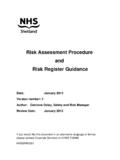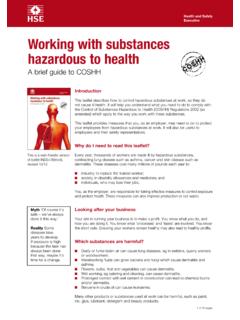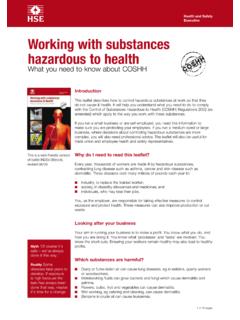Transcription of Metalworking fluids: Controlling inhalation …
1 TOPIC INSPECTION PACK Metalworking fluids: Controlling inhalation exposure to Metalworking fluids. Disease Reduction Programme (DRP) June 2006 1 CONTENTS 1. PURPOSE OF THE INTERVENTION 3 2. KEY MESSAGES 3 3. WHAT THE LAW REQUIRES 4 4. ENFORCEMENT MANAGEMENT MODEL (EMM) 4 5. INSPECTION GUIDELINES 4 6. INSPECTION TIPS 5 7.
2 ENFORCEMENT GUIDANCE 6 8. RISK CONTROL INDICATORS 10 9. FURTHER GUIDANCE 10 10. APPENDICES 11 Appendix 1 - 1 Principles of good practice (COSHH Regulation (a) Schedule 2A) Appendix 2 - Top Tips Appendix 3 - COSHH Essentials direct control sheets Appendix 4 - Inspection Aide Memoire 21.
3 PURPOSE OF INTERVENTION HSE has established a Disease Reduction Programme (DRP) as part of the FIT3 Strategic Programme. The aim of the Disease Reduction Programme is to achieve a reduction in the incidence of work-related ill health caused by exposure to hazardous agents. Respiratory disease accounts for a significant proportion of work-related ill health, and therefore a specific respiratory disease project has been set up to address this. The respiratory disease project aims to achieve a 10% reduction in new cases of occupational asthma by 2007/08 compared with 2003/04. A growing concern is the risk of asthma, extrinsic allergic alveolitis (EAA) and other breathing problems from exposure to mist from Metalworking .
4 Work-related asthma is a significant and growing problem with an estimated 1,500 to 3,000 new cases each year. On average, up to 2003, at least 20 of these cases were associated with exposure to Metalworking fluids (MWFs) but it is thought many more cases go unrecognised. There are also thought to be the same risks of respiratory disease arising from exposure to mist from water mix wash fluids used to clean machined components. There has been one large outbreak of respiratory illness in the UK at a single site, peaking in 2003, where over 100 workers have been diagnosed with respiratory illness (both occupational asthma and EAA) as a result of exposure to mist.
5 At the site there was mist from both Metalworking and washing machines. There are also a number of smaller outbreaks under investigation. As a result, HSE began an initiative in 2005/6 to reduce the risk of respiratory (and skin disease see separate Topic Pack) from Metalworking fluids by targeting large users of Metalworking fluids, to improve controls and management of fluids see SIM 03/2005/03. This project continues the initiative by targeting smaller users of MWFs to raise awareness of - how MWFs affect health - how exposures occur - how control measures can minimise exposures - how to check that controls are working - the importance of health surveillance - the need to ensure that key preventative measures are being followed.
6 See SIM 03/2006/6. This inspection pack provides information to HSE inspectors who will be carrying out the visits to smaller users of MWFs. 32. KEY MESSAGES AND PREVENTATIVE MEASURES To increase awareness of the problem by completion of suitable and sufficient risk assessments To ensure Metalworking fluids start clean and stay clean, by monitoring the condition of the fluid To reduce respiratory exposure by preventing an Controlling mist from the machining and washing of components To check that controls are working by looking for symptoms through health surveillance 3.
7 WHAT THE LAW REQUIRES Metalworking fluids are hazardous substances under the Control of Substances Hazardous to Health Regulations 2002 (as amended). The guidance limits for Metalworking fluids that were introduced in HSG 231 have recently been withdrawn as it became apparent that there could be respiratory effects at concentrations below the guidance limit for water-mix Metalworking fluids in particular. A suitable and sufficient assessment of the risk to health from exposure to MWF is required by Regulation 6 of COSHH. In order to achieve adequate control an employer must apply the principles of good control practice in Schedule 2A of COSHH (Regulation (a)).
8 See Appendix 1. Exposure to substances that cause occupational asthma should be reduced to as low as reasonably practicable (COSHH Regulation (c)(ii)). Currently there is no standard WEL for Metalworking fluids (but individual workplace limits may be set). 4. ENFORCEMENT MANAGEMENT MODEL (EMM) EMM was set up to help inspectors reach a proportionate enforcement decision. It is used to determine the risk gap, risk-based decisions and compliance issues. It also takes account of the Initial Enforcement Expectation, taking account of the different authority in law of the standards of control required.
9 In terms of the EMM, both occupational asthma and extrinsic allergic alveolitis are described as serious health effects. The benchmark standard is set as nil or negligible risk. For exposure to Metalworking fluids this can be achieved by (1) where possible eliminating the need 4to use Metalworking fluids (this is unlikely to be possible in the majority of situations); OR (2) managing the quality of the Metalworking fluid ; (3) reducing the amount of mist generated at the machining/washing process; (4) providing extracted enclosures or installing LEV at machinery where emissions/exposure occur, (5) using suitable Respiratory Protective Equipment (RPE) in combination with other control measures where appropriate, and other Personal Protective Equipment (PPE) gloves; and (6) providing health surveillance.
10 Exposures above any WEL for MWF will result in an extreme risk gap. To accommodate ALARP; exposure at any WEL for MWF will produce a substantial risk gap. Both scenarios have initial enforcement expectation of an Improvement Notice. 5. INSPECTION GUIDELINES General Information Metalworking fluids (MWFs) are neat oils or water-based fluids used during the machining of metals to provide lubrication and cooling. They are sometimes referred to as suds, coolants, slurry or soap. The water-based fluids are a complex and variable mix of chemicals, mixed to a predetermined percentage with water.














